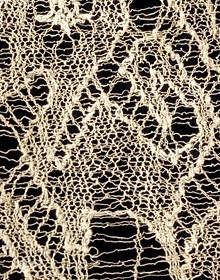resources
Museum Collections - Ancient Peru - Chancay

Before the impact of the Chimú was fully felt, a style known as Chancay spread across three coastal valleys in northern Peru - Huaura, Chancay and Chillon. The Chancay culture possessed a certain degree of political integration, but did not forge an organized state. Its architecture was undistinguished and produced in tapia (poured adobe). Chancay ceramics were distinct, but rough in execution. Vessels were often large, and included egg-shaped jars and female effigies with short arms. They are usually characterized by black (and occasionally red) painting on a white slip with a matte finish.
The Chancay are known more for their textiles than for their ceramics. Textiles from elite Chancay tombs include elaborate gauzes, embroidery, painted plain weave and tapestry, and three-dimensional fibre sculptures. Fine mesh-like openwork (see left image), achieved a new level of artistry and skill. Women wore head cloths, with complex patterns of snakes and interlocked birds. Many thousands of Chancay textiles are preserved in museums around the world, attesting to their prolific artistic output.






